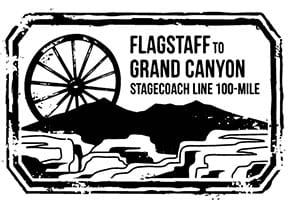Run or ride the Arizona Trail from Flagstaff, Arizona to the Grand Canyon across the ancestral lands of the Hopi, Zuni, Havasupai, Hualapai, Southern Paiute, Navajo and many other indigenous people. The racecourse roughly follows the historic stagecoach line tourists took to reach the Grand Canyon in the 1890s. The …
MORE
Run or ride the Arizona Trail from Flagstaff, Arizona to the Grand Canyon across the ancestral lands of the Hopi, Zuni, Havasupai, Hualapai, Southern Paiute, Navajo and many other indigenous people. The racecourse roughly follows the historic stagecoach line tourists took to reach the Grand Canyon in the 1890s. The route includes singletrack, doubletrack, and forest roads along the Arizona National Scenic Trail through high desert and alpine terrain. We’ve added more trail miles for the 100-mile runners and MTBers.
Run or ride through expansive ponderosa pine and piñon-juniper forests, grasslands, and golden leafed aspen stands. The course starts near 7,500 feet and reaches a maximum elevation near 9,000 feet. The 100-mile has about 7,000 feet of gain. The 55k has roughly 2,300 feet of gain. There’s a 31.5-hour cut-off for 100-mile runners/relays and 15-hours to complete the 100-mile bike ride/relay. 55k runners have 10 hours to complete the course.
This event begins a few miles north of Flagstaff, Arizona, at the Flagstaff Hotshots Ranch off Snowbowl Road and finishes in Tusayan, Arizona, the entrance of the Grand Canyon National Park. A majority of the Stagecoach course follows the Arizona Trail and the historic Flagstaff to Grand Canyon Stagecoach Line route used by adventure seeking tourists between 1897 and 1901. Many of today’s race-day aid stations are located at the original stage line rest stops and watering holes. Course footing varies between single-track, two-track and maintained forest dirt roads. Runners pass from heavily vegetated ponderosa pine and alpine aspen forests to sparsely vegetated pinion-juniper grasslands and back again. The 100-mile course starts at 7,400’ (Hotshots Ranch), reaches a maximum elevation of 8,800’ (at Aspen Corner, mile 6), finishes at 6,600’ (Tusayan) and has approximately 7,000’ of climbing. Runners traverse over a shoulder of Arizona’s highest mountain, Humphrey’s Peak, through the high alpine meadows of the Hart Prairie Preserve, across 422-square mile Babbitt Ranches, and along the Coconino Rim where views of the Grand Canyon, Painted Desert, and Navajo Mountain await.
If you’re interested in moving your body across ultra distances filled with some of the most iconic scenery in the West, join this September!
LESS

Amazing Scenery, Hard Course
Overall Rating: Excellent. Course Difficulty: This is a mountain course that is mostly above 7000' with massive climbs and descents. The terrain is pretty technical, which can be interpreted as … MORE
Overall Rating: Excellent.
Course Difficulty: This is a mountain course that is mostly above 7000′ with massive climbs and descents. The terrain is pretty technical, which can be interpreted as – your feet and ankles are going to hurt…bad! I ran for about 20 miles and power hiked most of the rest, I think it may have been the altitude, but my legs were just plain tired. It rained, sleeted, and hailed which added to the challenge, and temps ranged from 75 to 35, so wearing correct clothing must be a priority.
Course scenery: I feel this is overall the most beautiful course I have run, simply amazing. The 100 mile runs over the shoulder of a mountain, through plains, and across surreal landscapes.
Race Production: Great, mostly.
Everything was on time and where it was supposed to be. I had a little issue with packet pick up, mostly because I am in old introverted country boy who doesn’t know how to park in town. I prefer packet pickup to be in a wide open field so I can navigate easily, but I get that there is an entirely new generation (that is the future of ultra running) that loves being right in the middle of the action…so I get it. Location aside (for me), race production was excellent, course was well marked (I only got lost once in 100 miles), aid stations were fantastic, and the RD was on the course in the middle of the action. It was produced very well.
The one real issue I ran into was course length. The course had a couple of extra miles in it, and varied from the cue cards that we were encouraged to carry. While a couple of extra miles on a course are no big deal, not knowing they are coming and being right at the end hurt, a lot.
Race Swag: Nice shirt, sticker and awesome buckle!
My Performance: I’m ok with this one. I struggled more than I thought, but my thoughts were based on things I had no real experience with…mountains. It hurt, but 100 milers hurt, so all in all, I’ll mark this down as a success. It was a PR, so I’ll take it.
Final notes: This is not a beginner race; of the 108 starters in the 100 miler, only 61 finished. It is hard! It is also beautiful and rewarding if you can get it done. If you are going to try this one do your homework, allow about 12 hours to drive the course the day before, take a high clearance vehicle, and be prepared for any weather. If you will keep moving forward, you can get it done…even at a walk.